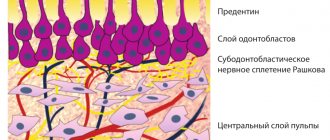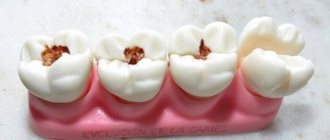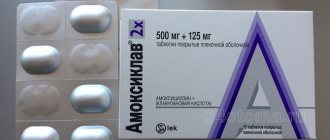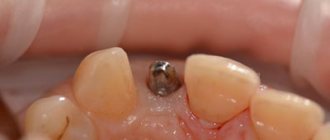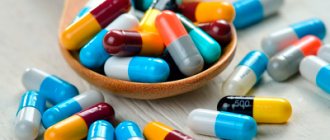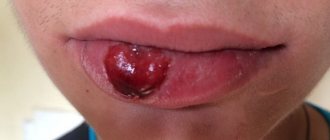Periodontal disease is a deep damage to the gums, bone and periodontium (the complex of tissues that hold the tooth in the alveolus). The main danger of the disease is its inconspicuous development - in the initial stages of periodontal disease there is no inflammatory process, pain or suppuration. It is these symptoms that prompt a person to see a dentist and start treatment on time.
Meanwhile, periodontal disease gradually leads to loss and destruction of bone tissue, the gums recede and become loose, and the tooth root is exposed. The root system loses stability, teeth become loose and fall out.
If you have been diagnosed with periodontal disease, prepare for long-term treatment. It is not enough for you to put your oral cavity in order; it is important to restore the general condition of the body.
To prevent complications, it is important to identify pathology at an early stage. To do this, have regular checkups with your dentist. Then you can get rid of the disease faster, and the cost of treatment will be lower.
How to cure periodontal disease forever?
Treatment of any disease begins with diagnosis. In the case of periodontal disease, which is often asymptomatic, the following procedures are performed to make a final diagnosis:
- examination of the oral cavity;
- probing of the gingival sulcus;
- X-ray examination (orthopantomography);
- biomicroscopy of the gums to determine the degree of microcirculation impairment.
The main factor confirming the presence of periodontal disease is a uniform decrease in the height of the interdental septa with alternating foci of osteosclerosis and osteoporosis in the deep parts of the alveolar process and the body of the jaw, as well as in other bones of the skeleton. As a rule, all these manifestations are displayed on an x-ray. The patient will also need additional consultation with a general practitioner and an endocrinologist to identify and treat metabolic disorders, diseases of the cardiovascular or endocrine systems, which often accompany the disease.
How to get rid of periodontal disease and finally prevent bone tissue destruction? Unfortunately, it is impossible to completely say goodbye to the disease. For this reason, treatment of dental periodontal disease is usually aimed at slowing down the process of periodontal dystrophy and preventing tooth loss, tissue inflammation and purulent bone damage.
Consequences of periodontal disease
Periodontal disease requires urgent treatment, as it can lead to serious consequences:
- gingivitis;
- periodontitis;
- intoxication of the body with pus;
- loss of teeth;
- cancerous tumors;
- impossibility of prosthetics;
- pulpitis;
- serious problems in the gastrointestinal tract.
Specialists of the 32 Dent clinic network specialize in the treatment of all types and forms of periodontal disease. Every day, doctors help patients once and for all get rid of a problem that brings internal discomfort and unaesthetic changes.
Treatment methods for periodontal disease
The development of the disease can be slowed down by treating periodontal disease with medications and carrying out the following procedures:
- professional hygiene for timely removal of dental plaque;
- splinting to normalize occlusal relationships;
- the use of drugs for periodontal disease, vitamins and agents to improve microcirculation in tissues (nicotinic acid, aloe extract, heparin);
- massage to strengthen gums during periodontal disease;
- grinding of teeth;
- prosthetics;
- darsonvalization of gums;
- filling erosions.
Modern methods
The most effective treatment for periodontal disease is based on the use of more modern methods, listed below:
- exposure to high pressure oxygen in hyperbaric chambers;
- ultrasonic device for the treatment of periodontal disease;
- local hypo- and hyperthermia;
- diadynamic currents;
- amplipulse therapy;
- electrophoresis;
- UHF therapy.
Which doctor treats periodontal disease? Most patients do not know the answer to this question. A doctor who treats periodontal disease is called a periodontist. Be sure to contact this specialist if you notice pale coloration and receding gums, increased tooth sensitivity, or a wedge-shaped defect. Where to treat periodontal disease? Of course, in a dental clinic.
Surgical treatment of periodontal disease
Is it possible to cure advanced periodontal disease? The answer to the question is also negative. However, when treating advanced periodontal disease, surgical intervention is most appropriate. We are talking about the stage of the disease when the alveolar process is almost completely atrophied, and in order to prevent the loss of all teeth, the patient undergoes an operation to restore bone tissue during periodontal disease, which will keep the teeth in their places.
Types of periodontal disease
Depending on the location where periodontal disease spreads, it can be:
- Localized . It is located in a certain area of the dentition and does not spread further. Characteristic of the first stages of the disease.
- Generalized . Covers the entire dentition of one jaw or the upper and lower jaws simultaneously.
The course of the disease may include:
- Chronic. The disease is asymptomatic and the patient seeks help only when he notices obvious signs of pathology. It occurs most often and requires long and complex treatment.
- Spicy. Severe pain occurs, the gums bleed, and it is difficult for the patient to chew.
Remedies for periodontal disease
There is no best cure for periodontal disease, and a specific cure has not yet been invented. At the moment, relief from the symptoms of this disease is achieved only through special procedures and complex treatment of periodontal disease with drugs rich in amino acids, proteins and antioxidants. Taking vitamins for periodontal disease also helps accelerate metabolism in periodontal tissues. What vitamins can a doctor prescribe? Typically, as part of drug treatment for periodontal disease, dentists recommend taking the following vitamins and minerals:
- vitamin B6 and vitamin B12 – if periodontal disease develops against the background of pathologies of the digestive system, diabetes mellitus, neurasthenia;
- folic acid – to activate all metabolic processes in the body;
- zinc – for bone tissue regeneration;
- calcium – for mineralization of bones and teeth;
- selenium - for antioxidant and immunomodulatory effects.
You should not self-medicate. The doctor determines which drugs for periodontal disease should be used in each specific case, based on the results of dental diagnostics and the general condition of the patient’s body.
Antibiotics for periodontal disease
Patients are often interested in whether antibiotics are used for periodontal disease in adults? In the initial stages, this is not necessary, since there is no inflammatory process. However, severe degrees of the disease are sometimes accompanied by inflammatory complications. Here, treatment of periodontal disease with antibiotics is considered justified. What antibiotics do doctors usually prescribe for periodontal disease with inflammatory complications? These can be various drugs that help quickly stop inflammation.
Injections into the gums for periodontal disease
In addition to drug treatment, injections for periodontal disease are also used. These are injections of aloe extract, which is an effective biogenic stimulant. Typically, the course of treatment consists of 20 - 25 injections with a break per day. What injections for periodontal disease are prescribed if the disease has become severe? In the presence of an inflammatory process in the later stages of the disease, dental periodontal disease can be treated with injections with synthetic tissue regeneration stimulators according to the same scheme.
Causes
What provokes the development of periodontal disease and what is it? This is a systemic dental disease that is non-inflammatory in nature. Inexperienced people often confuse the disease described with the related disease periodontitis. However, these are completely different diseases. Periodontal disease is not characterized by bleeding or the formation of periodontal pockets where pus can accumulate. The unpleasant odor of periodontal disease from the gums is almost unnoticeable.
For your information! The causes of periodontal disease have not yet been established by medicine. However, the hereditary transmission of the disease is still recorded. In practice, it has been noted that the disease appears when there is dysfunction in the glands, in the presence of diabetes mellitus, when systemic diseases occur, in atherosclerosis, vegetative dystonia, hypertension and osteopathy.
Doctors have noted that gum damage by periodontal disease occurs due to impaired blood circulation in the gums, which over time causes tissue death and, as a consequence, tooth loss.
Plates for periodontal disease
Often solutions and ointments for the treatment of periodontal diseases are not effective enough, as they are quickly removed from the mouth with saliva. Therefore, it is necessary to apply products in the form of applications for periodontal disease. However, modern treatment of periodontal disease involves the use of an alternative form of drugs that allows active substances to better penetrate the epithelium to achieve a high regenerative effect. These are plates made from natural polymers (gelatin, collagen, sodium alginate) and medicinal substances that improve metabolic processes in tissues and increase vascular tone (mineral components, enzymes, herbs, vitamins, amino acids, organic acids, phytohormones).
How is periodontal disease treated with plates?
The product is applied to the gingival margin after brushing the teeth and gently pressed into the interdental spaces. Thanks to their adhesive properties, the plates can be held on the gums for 6 to 10 hours. Then their remains are removed with warm water.
The instructions for these plates say that they are intended to protect and improve periodontal tissue. But is it possible to cure advanced periodontal disease with their help? The answer is negative. This product is not intended specifically for the treatment of periodontal disease. It has a general strengthening effect on the entire periodontium as a whole and is more suitable for alleviating the symptoms of gingivitis and periodontitis in the form of bleeding and inflammation of the gums.
Antibiotics in modern periodontal practice
Eight major types of antibiotics have been widely studied and described for the treatment of periodontal disease: tetracycline, minocycline, doxycycline, erythromycin, clindamycin, ampicillin, amoxicillin, and metronidazole. 1. Tetracycline Pharmacology 1. Produced naturally from certain Streptomyces species or semi-synthetic derivatives. 2. Bacteriostatic drugs are more effective against rapidly reproducing bacteria and gram-positive bacteria than against gram-negative bacteria. 3. The concentration in the gingival crevice is 2-10 times higher than in the serum. 4. They have unique non-antibacterial characteristics - inhibition of collagenase, inhibition of neutrophil chemotaxis, anti-inflammatory effect, inhibition of microbial adhesion. Mechanism of action They act by inhibiting protein synthesis by binding to 30 S ribosomes in a susceptible organism. Clinical use 1. Adjuvant drug in the treatment of localized aggressive periodontitis. 2. Stops bone loss and suppresses A. actinomycetemcomitans levels in combination with scaling and root smoothing. Tetracycline, minocycline, and doxycycline are semisynthetic members of the tetracycline group that have been used in periodontal therapy. Dosage regimen: 250 mg four times a day. 2. Minocycline 1. Effective against a wide range of microorganisms. 2. Suppresses spirochetes and motile rods as effectively as scaling and root planing, with suppression up to 3 months after therapy. 3. Can be taken twice a day, which makes it easier to follow the rules of dosage. 4. Although associated with less phototoxicity and renal toxicity than tetracycline, it may cause reversible dizziness. 5. Increases the level of gingival fluid preparation by 5 times. 6. With the exception of the effect of minocycline on actinomycetes, none of the tetracyclines essentially inhibit the growth of oral gram-positive organisms by systemic delivery. 3. Doxycycline 1. Same spectrum of activity as minocycline. 2. Convenient to take as it must be taken once daily, absorption from the gastrointestinal tract may be only slightly altered by calcium, metal ions or antacids. 3. The recommended dose is 100 mg 2 times a day on the first day, then 100 mg. To reduce gastrointestinal distress, 50 mg can be taken 2 times daily. A comparison of the biological effects, peak concentrations of tetracyclines after systemic administration at the usual adult dose is shown in Table 1. 4. Metronidazole Pharmacology 1. A synthetic nitroimidazole compound with bactericidal effects is mainly used against obligate gram-positive and gram-negative anaerobes. Campylobacter rectus is the only facultative anaerobic and probable periodontal pathogen that is susceptible to low concentrations of metronidazole. 2. Spectrum of activity of the drug: excellent treatment of infections caused by Fusobacterium and Selenomonas, the best drug affecting Peptostreptococcus infections, average effectiveness against infections caused by P. gingivalis, Pintermedia and C. rectus, low effectiveness against infections caused by A. actinomycetemcomitans and E. corrodens infections, does not significantly inhibit the growth of beneficial bacterial species 3. Concentrations measured in gingival fluid are usually slightly less than in plasma. Mode of Action Metronidazole acts by inhibiting DNA synthesis. Clinical Uses 1. For the treatment of gingivitis, acute necrotizing ulcerative gingivitis, chronic periodontitis and aggressive periodontitis. 2. Metronidazole is not effective as monotherapy and should be used in combination with root planing, surgery, or other antibiotics. The most commonly prescribed regimen is 250 mg three times daily for 7 days. 3. A study by Haffajee et al examined patients with pocket depth ≥6 mm. Patients treated with metronidazole or azithromycin showed significantly greater reduction in pocket depth and greater attachment enhancement than patients treated with doxycycline. 5. Penicillin Pharmacology 1. Natural and semi-synthetic derivatives of broth cultures of Penicillium mold. 2. Narrow spectrum and bactericidal nature. The main activity is in the gram-positive spectrum. Only broad-spectrum penicillins, such as ampicillin and amoxicillin, have significant antibacterial antimicrobial activity for gram-negative species. Mode of action Interferes with bacterial cell wall synthesis, inhibits transpeptidases so that cross-linking does not occur. Clinical use 1. In the treatment of patients with aggressive periodontitis, both localized and generalized forms. The recommended dose is 500 mg three times a day for 8 days. 2. Shows high antimicrobial activity against bacteria that are found in periodontal fluid, with the exception of E. corrodens, S. sputigena and Peptostreptococcus, inhibits the growth of gram-positive facultative anaerobes. Studies show that more than 60% of adult patients with periodontitis who were sampled for periodontal plaque analysis exhibited β-lactamase activity. For this reason, administration of β-lactamase-sensitive penicillins, including amoxicillin alone, is generally not recommended and in some cases may accelerate periodontal destruction. Amoxicillin-clavulanate (Augmentin). A common strategy is to administer amoxicillin with a beta-lactamase inhibitor such as clavulanic acid. Augmentin may be useful in the treatment of patients with refractory or localized aggressive periodontitis. In targeted tissue regeneration, systemic amoxicillin-clavulanic acid therapy has been used to suppress periodontal pathogens and increase clinical attachment gain. 6. Cephalosporins Pharmacology 1. Used against infections that could otherwise be treated with pencillin. 2. Resistant to a number of β-lactamases, usually active against penicillin. Mode of action Same mode of action as penicillins, i.e. inhibition of bacterial cell wall synthesis. However, they bind to different proteins than those to which penicillins bind. Clinical Use Cephalexin is a cephalosporin available for administration in an oral dosage form. 1. Reaches high concentrations in periodontal fluid. 2. Effectively inhibits the growth of gram-negative obligate anaerobes, does not interfere with gram-negative facultative anaerobes. 3. Newer cephalosporins with increased gram-negative efficacy may be useful in the treatment of periodontal disease. 7. Clindamycin Pharmacology Effective against anaerobic bacteria and in patients allergic to penicillin. Mode of action Inhibition of protein synthesis by binding to the 50 S ribosome. Clinical Uses 1. Clindamycin achieves higher levels of antimicrobial activity than other antibiotics. 2. Gordon et al observed a mean clinical attachment gain of 1.5 mm and a decrease in disease activity in patients 24 months after adjunctive clindamycin therapy. 3. Walker and co-authors showed that clindamycin helps stabilize the disease in difficult-to-treat patients. The dosage was 150 mg 4 times a day for 10 days. 4. Jorgensen et al recommended a regimen of 300 mg BID for 8 days 8. Ciprofloxacin Pharmacology 1. Fluoroquinolone antibiotic available for oral administration. 2. Potent inhibitor of Gram-positive bacteria (all facultative and some anaerobic putative periodontal pathogens), including Pseudomonas aeruginosa, with MIC 90 values ranging from 0.2 to 2 μg/ml. Mode of Action Inhibits bacterial DNA replication and transcription by inhibiting the enzyme DNA gyrase, an enzyme unique to prokaryotic cells. Clinical Uses 1. Promotes microflora associated with periodontal health with minimal effects on streptococcal species that are associated with periodontal health. 2. Currently, ciprofloxacin is the only antibiotic in periodontal therapy to which all strains of A. actinomycetemcomitans are sensitive. 3. Also used in combination with nitroimidazoles (metronidazole and tinidazole). 9. Macrolides Pharmacology 1. Contains a polylactone ring to which one or more deoxysugars are attached. 2. Can be bacteriostatic or bactericidal, depending on the concentration of the drug and the nature of the microorganism. 3. Macrolide antibiotics used for periodontal treatment include erythromycin, spiramycin, and azithromycin. 4. The main limitation of erythromycin is its poor tissue absorption. Formulations for systemic administration are available as prodrugs (erythromycin estolate, erythromycin stearate, or erythromycin ethyl succinate) to facilitate absorption. The prodrug has little antibacterial activity until it is hydrolyzed by esterases in serum. Mode of action Inhibits protein synthesis by binding to the 50 S ribosomal subunits of sensitive microorganisms and interfering with translation. Erythromycin Clinical Uses 1. A very safe drug that is often recommended as an alternative to penicillin for patients with allergies. 2. Gingival fluid levels indicate that only a small portion reaches the periodontal pocket via the oral route. Spiramycin It is excreted in high concentrations through saliva. Results from various clinical trials have demonstrated good efficacy of spiramycin in the treatment of periodontitis, and a meta-analysis of these studies has shown high levels of evidence supporting its effectiveness. It has been shown to reduce the amount of periodontal fluid, pocket depth and spirochetes at the subgingival level. Herrera et al, in a meta-analysis evaluating spiramycin, amoxicillin plus metronidazole, and metramidazole, showed a statistically significant additive effect of spiramycin compared with other antibiotics in reducing pocket probing depth for sites with initial probing depth greater than 6 mm Clinical Use Effective against Gram-positive organisms , has minimal effect on increasing the level of attachment. Azithromycin Clinical Uses 1. Effective against anaerobes and gram-negative rods. 2. Following an oral dose of 500 mg for 3 days, significant levels of azithromycin can be detected in most tissues within 7-10 days. 3. It has been suggested that azithromycin enters fibroblasts and phagocytes at concentrations 100-200 times higher than those in the extracellular compartment. Azithromycin is actively transported to sites of inflammation by phagocytes and then directly released at sites of inflammation as phagocyte rupture during phagocytosis. 4. Therapeutic use requires a single dose of 250 mg/day for 5 days after an initial loading dose of 500 mg. 10. Aminoglycosides 1. Inhibit protein synthesis by binding irreversibly to a specific protein or proteins of the 30 S-ribosomal subunit. 2. Inactive under anaerobic conditions because intracellular transport is greatly impaired in the absence of oxygen. Therefore, all anaerobic bacteria are very resistant, although they contain ribosomes that are sensitive to these antibiotics.
How to treat periodontal disease with folk remedies?
Treatment of dental periodontal disease with folk remedies will not bring results. No rinses or decoctions can cope with bone tissue degeneration. And following advice from articles on the Internet that recommend using hydrogen peroxide or other chemicals to eliminate periodontal disease is not only pointless, but also dangerous to your health. It is important to understand in time that this is a serious disease that requires qualified assistance from a periodontist, and to seek treatment for periodontal disease at the dentist.
Prevention of periodontal disease
There are few preventive measures to prevent the appearance and development of periodontal disease, since the pathology is associated with genetic predisposition and metabolic disorders in the body. In general, doctors recommend maintaining overall oral hygiene through regular brushing and flossing.
You should also follow a certain diet for periodontal disease and to prevent the disease. It is recommended to eat more milk, vegetables, seafood, unrefined vegetable oils, and limit carbohydrate intake. The diet for the prevention and treatment of periodontal disease in adults should include a sufficient amount of raw vegetables and fruits, which promote self-cleaning of teeth from plaque and have a massaging effect on the gums, improving their microcirculation.
Symptoms
At the initial stage, the disease can only be detected by a dentist. Patients realize that something is wrong only when they notice bleeding gums and bad breath.
You urgently need to contact a periodontist if:
- Yellow plaque and tartar appear on the teeth in a larger volume. It is difficult to get rid of mineralized deposits, even if the patient monitors oral hygiene;
- itching and burning of gums;
- gums turn pale;
- gum tissues recede and tooth roots become visible;
- discomfort occurs when eating salty and sweet foods, as well as when chewing hard foods;
- feel pain when brushing your teeth;
- interdental distances at the roots of teeth increase;
- the teeth shift to one side, the area of the dental crown lengthens, and when you smile, the impression of “horse teeth” appears.
